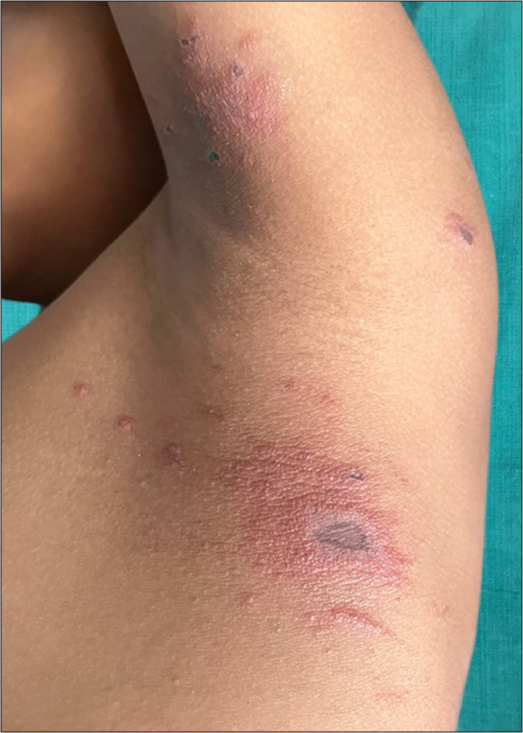Translate this page into:
Paederus dermatitis presenting with kissing lesions in a 12-year-old boy

*Corresponding author: Vishal Gaurav, Department of Dermatology and Venereology, Maulana Azad Medical College, New Delhi, India. mevishalgaurav@gmail.com
-
Received: ,
Accepted: ,
How to cite this article: Barman KD, Gowda P, Gaurav V. Paederus dermatitis presenting with kissing lesions in a 12-year-old boy. CosmoDerma. 2025;5:21. doi: 10.25259/CSDM_226_2024
A 12-year-old boy presented with painful erythematous lesions in the left infra-axillary region and on the medial aspect of the proximal upper arm, without any systemic symptoms. The lesions appeared after the boy noticed a burning sensation in the affected areas the night before, following an outdoor activity during the rainy season. Examination revealed well-demarcated erythematous plaques with vesicles, pustules, and a central zone of dusky erythema, displaying a mirror-image distribution in the infra-axillary area and the opposing medial proximal upper arm, indicative of “kissing lesions” [Figure 1]. The boy had no history of similar episodes, insect bites, or contact with known allergens.

- Well-demarcated erythematous plaques with vesicles, pustules, and a central zone of dusky erythema, displaying a mirror-image distribution in the infra-axillary area and the opposing medial proximal upper arm, indicative of “kissing lesions.”
Paederus dermatitis, also known as blister beetle or Nairobi fly dermatitis, is an irritant contact dermatitis caused by exposure to the coelomic fluid of the Paederus beetle, which contains the potent toxin pederin. This condition is particularly common in tropical and subtropical regions during the rainy season when these beetles are more active. The lesions typically present as kissing lesions in flexural areas or appear linearly elsewhere due to the crushing or rubbing of the beetle, which releases the toxin and causes dermatitis. In this case, the boy likely crushed the insect against his skin, leading to the release of pederin and subsequent dermatitis. Management involves symptomatic treatment, including topical corticosteroids and oral antihistamines. Preventive education is essential, advising patients to avoid crushing these beetles against the skin and to wash the affected area immediately if contact occurs. Paederus dermatitis should be considered in cases of sudden-onset erythematous and vesicular lesions during the rainy season in tropical regions.[1]
Ethical approval
Institutional Review Board approval is not required.
Declaration of patient consent
The authors certify that they have obtained all appropriate patient consent.
Conflicts of interest
There are no conflicts of interest.
Use of artificial intelligence (AI)-assisted technology for manuscript preparation
The authors confirm that there was no use of artificial intelligence (AI)-assisted technology for assisting in the writing or editing of the manuscript and no images were manipulated using AI.
Financial support and sponsorship
Nil.
References
- Paederus dermatitis. Indian J Dermatol Venereol Leprol. 2017;83:424-31.
- [CrossRef] [PubMed] [Google Scholar]






